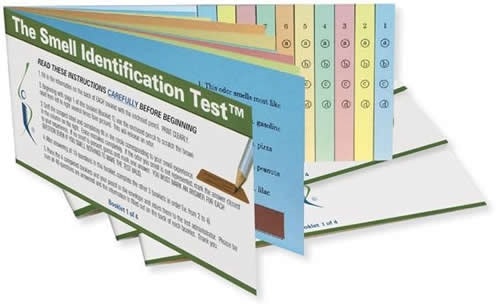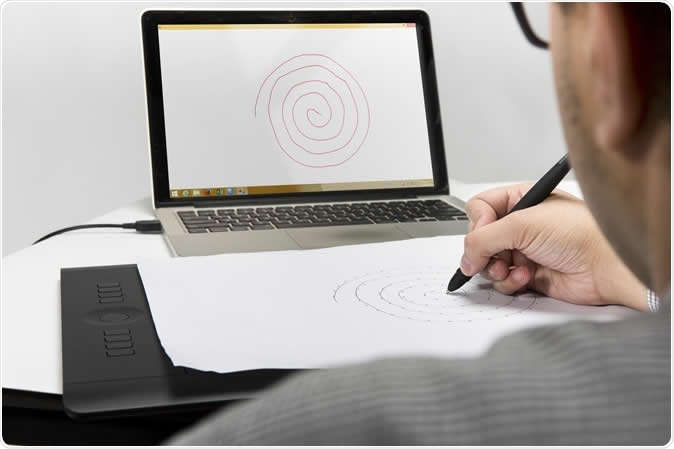Smell Test and Detection of Parkinson’s Disease
According to a new study from the Michigan State University, a simple “scratch and sniff” test could be enough to predict Parkinson’s disease before it starts is debilitating curse. Honglei Chen, lead author and professor of epidemiology, Michigan State University, this test could identify the persons at risk of developing Parkinsonism at least a decade before it can be actually diagnosed. Sense of smell has been associated with the progression of this disease in the past but this is the first study of its kind that shows the predictive value of a simple test.

A new Michigan State University study provides further evidence that a simple scratch-and-sniff test could predict Parkinson's disease even earlier than previously thought. IMAGE CREDIT: Michigan State University
The study is published online in Neurology, the official publication of the American Academy of Neurology. This study was funded by The National Institute on Aging, National Institute of Nursing Research and National Institute of Environmental Health Sciences.
Chen also noted that this was one of the first studies that followed older black as well as white participants for around a decade. This time period is also more than any other research on this done previously. For up to six years the sense of smell has been linked to the disease after which the association remained but was not strong enough to be predictive. The strength of the association was weaker among black participants compared to the white population noted Chen and his colleagues.
For this study 1510 white and 952 black participants were included. The average age of the participants was 75 years. The enrolled participants were asked to smell 12 common odours including lemon, cinnamon, soap, onion and gasoline. They were given four options for each of the smells and were asked to choose an option from them. After the participants performed the test they were classified into three groups – those with poor sense of smell, those with medium sense of smell and those with good sense of smell. These participants were then followed up for almost 10 years thereafter through their health visits as well as via phone calls and phone interviews. During the period of follow up, 42 persons in the study population went on to develop Parkinson’s disease including 30 white persons and 12 black persons.
Results revealed that those with a poor sense of smell were five times likely to develop Parkinsonism compared to those with a good sense of smell. For example, of the 764 persons who had poor sense of smell to begin with, 26 developed the disease. On the other hand, nine out of 863 persons with medium sense of smell and seven out of 835 persons with good sense of smell developed Parkinson’s disease. The study results showed that older men who had a poor sense of smell were more likely to develop Parkinson’s disease compared to women.
Chen is a part of the MSU's Global Impact Initiative and he says that there have been studies earlier that find that black populations may have a poorer sense of smell compared to whites and are less likely to develop Parkinsonism. In this study per se there was no significant finding about the poor sense of smell in blacks and its association with Parkinsonism he said and added that more research in this area was needed to be conclusive.
Researchers were careful to adjust for other factors that were likely to affect the results including a history of smoking or head injury and excessive coffee intake etc. Chen explained that not all persons who had a low sense of smell developed Parkinson’s disease and this should be kept in mind. Further research is necessary before the smell test can be used as a screening tool for Parkinson’s disease he added. However, this study is an important step in the understanding of the risk factors associated with the disease he noted.
Drawing Spirals and Detection of Parkinson’s Disease
Australian researchers have reported in their latest study that a simple test that involves drawing a spiral on a surface could help detect Parkinson’s disease early. The pressure exerted by the pen on the surface and the writing speed could both account for the predictive values of this test. This latest study was published in the Frontiers of Neurology.

Researchers developed specialized software and combined it with a tablet computer that can measure writing speed, and a pen that can measure pressure on a page. They used the system to measure pen speed and pressure during a simple spiral sketching task in a sample of healthy volunteers and Parkinson's patients with different levels of disease severity. IMAGE CREDIT. Dinesh Kumar and Ms. Poonam Zham of the 'Affordable diagnostics' group in RMIT University, Melbourne, Australia
Researchers from Melbourne believe that this could be a simple way to detect an abnormality in the movement and future Parkinsonism risk and could be used by GPs in their day to day practice. The study involved 55 participants and of these 27 had Parkinson’s disease while 28 were free from the disease. Participants were given a tablet device with a software to detect the speed of their drawing and the pressure of the pen applied on the surface. The software system that combines the pen speed and pressure in one mathematical measurement is called the Composite Index of Speed and Pen-pressure (CISP) score. Parkinson’s disease patients were seen to have a slower speed of drawing and a lighter pressure of the pen while drawing found the study.
New diagnostic tool spots first signs of Parkinson’s disease | RMIT University
>
According to Poonam Zham, study researcher from RMIT University, the aim of this study was to develop an inexpensive and automated electronic system that could help to diagnose early stages of this debilitating disease. The test would be simple to use so that the community doctor as well as nursing staff could use it. The speed and the pressure of the pen could predict the severity of the disease, which no other current test can. Experts believe that this test could help clinical trials select more appropriate patients with similar severity so as to make the trials more fool proof. Well designed and conducted clinical trials could mean rapid and better introduction of new drugs for this disease.
Parkinson’s Disease
Parkinson’s disease is a neurodegenerative disease that causes damage to a core area of the brain that is involved in movement and muscle control leading to severe uncontrolled shaking and muscle rigidity that leads to difficulty in movement and performing regular tasks. Most of the drug treatments available work during early stages and with time the disease is progressive and completely debilitating.
Source: http://journal.frontiersin.org/article/10.3389/fneur.2017.00435/full